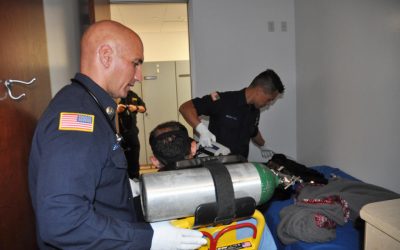
Picture yourself on a call with a patient who had hip surgery a week ago and today suddenly felt short of breath. Her oxygen saturation is 82% on room air so you place a non-rebreather (NRB) mask on the patient and turn the flowmeter to 15 LPM, enough to keep the bag no more than 1/3 depleted. Her breath sounds are clear with good aeration to both bases. There is no tracheal deviation; chest rise is symmetrical and the patient is breathing at a rate of 18-20 bpm. The oxygen saturation creeps up to 90%. You are an hour from your final destination with heavy traffic ahead.
Given this scenario, have you ever asked yourself: “Do I have enough oxygen to complete this mission?” You started your shift with 1,100 psi in your on-board tank and had a portable tank with 1,500 psi. You used oxygen on two earlier runs, both nasal cannula patients, one running at four and the other at six LPM. Both runs were just under an hour. Can you accurately determine how much time and oxygen you have in the ambulance for your hypoxic patient? You should. In fact, this calculation is an EMT level competency.
I strongly recommend that you know what size oxygen tanks your service uses and commit to memory the tank conversion factor for each tank. Most ambulances carry one or two M tanks to supply the on-board needs through flow meters and 50 psi ports — along with two to three D cylinders — for use outside the ambulance. There are many apps available today for calculating oxygen tank duration; all seem accurate in their results. I like to default to the old school math just in case my phone crashes.
Back to your patient. First and foremost, we need to assess and treat the patient’s immediate needs. Does the patient need oxygen, ventilation, or both? For this scenario we’ll start with oxygenation since we chose the NRB mask. How do we know how much time we have left on our oxygen tank? Here is where knowing a formula and tank sizes comes in. The tank size and pressure in the tank are the first two things you need to know. Using these, you can determine how many liters of oxygen your tank is designed to hold and figure a tank conversion factor. The oxygen cylinder duration can then be calculated by the liter flow per minute on the device you are using. This calculation will give you minutes of oxygen delivery.
The formula for cylinder duration is:
(Tank pressure in psi – Safe Residual Pressure*) x (Tank Conversion Factor)
Flow rate in liters/minute
* Safe Residual Pressure: A pressure of 200 psi is used as a precaution to prevent running out of oxygen at an inconvenient moment. Your EMS service may use a different value (some use 500 psi) as a safe residual pressure. Any tank that reaches the designated safe residual pressure should be replaced with a full tank.1
Tank Conversion Factors2
D=0.16
E=0.28
M=1.56
G=2.41
H=3.14
K=3.14
Example: Using the above scenario you check your M tank before placing the patient on the NRB and have 1,000 psi in the tank.
(1000 – 200) x 1.56 = 1,248 = 83.2 minutes
15 LPM 15
You also need to consider that the patient’s condition may change from when you first calculated oxygen tank duration. If the patient becomes tachypneic and you see the reservoir bag on the NRB mask deflating with every breath, you will need to increase your oxygen flow (LPM) to keep the bag from deflating no more than 1/3 with each inspiration. This is known as a flush setting and can may require as much as 40-60 LPM. That would drastically reduce your time available on the oxygen tank.4
It is important to know how much flow is needed to meet the patient’s respiratory needs. Typically, we place a patient on an NRB mask when their saturations reach an unacceptable level. This is where your assessment skills come into play. If the patient needs an oxygen percent of 30-35%, do they really need an NRB running at 15 LPM? There may be other options to consider. Nasal cannulas are the most commonly used oxygen delivery devices.3 Can you determine how much FiO2 is being delivered to an adult patient receiving 3 LPM nasal cannula? There is a general rule for determining FiO2 at a specific flow rate via the nasal cannula. It is known as the “rule of fours”, “which states that the FiO2 will increase 4% for every Liter/Min above 1.”4 Here is an estimate of FiO2 delivery on a nasal cannula:
1L= 24%
2L= 28%
3L= 32%
4L= 36%
5L= 40%
6L= 44%
Please take note that these low flow cannulas are known as variable performance devices and the actual FiO2 delivered to the trachea varies from breath to breath. Imagine a patient on a 4 LPM nasal cannula (calculated FiO2 of 36%), breathing at a rate of 12 bpm with oxygen saturations of 94%. Suddenly, they become agitated and start breathing at 22-25 bpm. The fixed flow of 4 LPM remains the same, but as the patient increases their respiratory rate they entrain more room air (21% FiO2) and dilute the 36% oxygen you are delivering. This is why we need to be prepared to titrate our liter flow to meet a target oxygen saturation.
When you get in your rig for a long shift do you check the fuel gauge? Do you make sure you have enough fuel for any unscheduled delays? We should always do the same with our oxygen supplies when preparing for a transport. Try this exercise the next time you start your shift. Calculate how much time you have on your onboard and portable tanks for a patient requiring a NRB mask at 15 LPM. You may be surprised at the answer! The patient’s safety is our responsibility and knowing how much oxygen is available under a multitude of situations is paramount in our profession. I encourage you to memorize the tank duration formula so you never have to say: “What? We ran out of oxygen?”
References
- Pollak, A. (2017). Nancy Caroline’s Emergency Care in the Streets (8th edition). Burlington, MA: Jones & Bartlett Learning.
- Pollak, A. (2018). Critical Care Transport (2nd edition). Burlington, MA: Jones & Bartlett Learning.
- Hess, D., McIntyre, N., Galvin, W., Mishoe, S. (2016). Respiratory Care: principles and practice (3rd edition). Burlington, MA: Jones & Bartlett Learning.
- Volsko, T., Chatburn, R., & El-Khatib, M. (2016). Equipment for Respiratory Care. Burlington, MA: Jones & Bartlett Learning.
Michael Schauf, RRT-NPS, has been a registered respiratory therapist at Albany Medical Center Hospital in New York since 1994. He covers all in-patient units, ICUs, the adult and pediatric Emergency Departments and is a member of the neonatal/pediatric transport team at this Level I Trauma and Level 3 NICU Center. Michael is the founder of Vent-Pro Training, teaching medics and nurses around the world how to manage mechanically ventilated patients during ground, rotor, and fixed-wing transports. He has been a flight respiratory therapist since 1998, currently working for AirMed and as a clinical education specialist for AMR. Michael authored the respiratory chapter of, “Critical Care Transport, 2nd edition,” published by Jones & Bartlett and is an adjunct instructor in the Respiratory Care Program at Hudson Valley Community College.


Excellent article,knowing how to calculate your tank pressure can be critical, for example at our service we do both 911 street calls and interfacility transfers. Knowing tank pressures, in case you need to run vents etc., for patients who require higher pressure settings is important. However, with regards to regular 911 calls, most areas are titrating O2 to SpO2. Example, if the patient is between 90-95% no O2 or use nasal cannula at low flow and then titrate to effect. So given that a good EMT or Paramedic, should be able to adapt to situations as they come up. For… Read more »